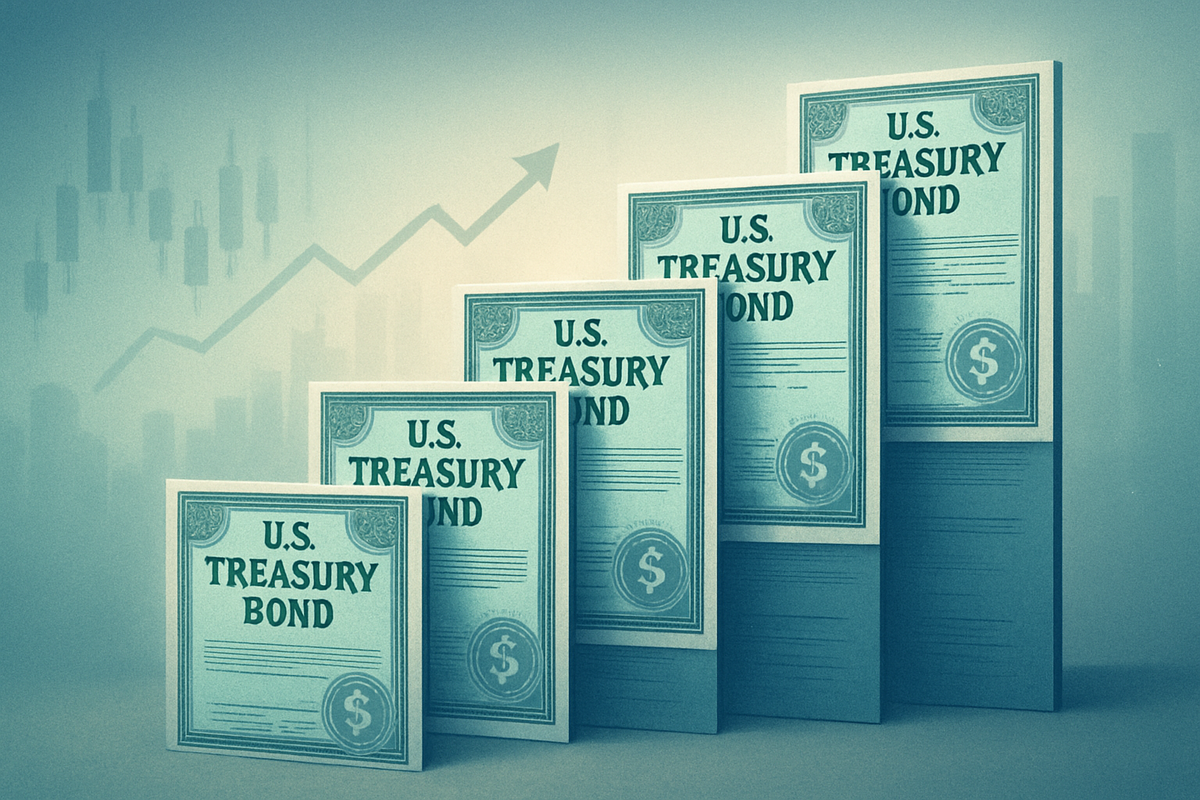
The Global X Short-Term Treasury Ladder ETF (NYSEARCA: SLDR) has recently announced a monthly dividend of $0.155 per share, translating to an attractive 3.7% forward yield. This declaration comes at a pivotal time in the financial markets, as the Federal Reserve has initiated an easing monetary policy while navigating persistent inflation and a cooling labor market. For investors seeking stable income and capital preservation in a potentially volatile rate environment, SLDR's consistent payout underscores its strategic positioning in short-term U.S. Treasuries.
This latest dividend, declared on October 31, 2025, and payable on November 10, 2025, to shareholders of record as of November 3, 2025, reflects an annual payout increase from $1.86 to $1.92. Such a move highlights the fund's ability to capitalize on prevailing market yields and distribute competitive income, positioning SLDR as a compelling option for those looking to mitigate interest rate risk while maintaining an attractive income stream.
Unpacking SLDR's Strategy and Market Dynamics
SLDR's dividend distribution is a direct reflection of its meticulously crafted investment strategy, which centers on a laddered portfolio of short-term U.S. Treasury notes. The ETF aims to mirror the performance of the FTSE US Treasury 1-3 Years Laddered Bond Index, holding a diversified basket of Treasuries with remaining maturities between one and three years. The "laddering" technique is crucial, involving two equally weighted rungs—one for 1-2 year maturities and another for 2-3 year maturities. As bonds mature, the proceeds are seamlessly reinvested into the next rung, ensuring continuous exposure and effectively mitigating interest rate volatility. This continuous rollover mechanism allows SLDR to consistently capture prevailing market yields, which are then distributed to shareholders monthly.
The market backdrop as of November 3, 2025, provides significant context for this dividend. The Federal Open Market Committee (FOMC) recently cut the federal funds rate by a quarter-point to 3.75%-4.0% in October 2025, marking the second such cut of the year. Concurrently, the Fed concluded its quantitative tightening program, signaling a broader shift towards looser monetary conditions. Despite these easing measures, inflation, as measured by the PCE price index, remains above the Fed's 2% target at an estimated 2.8% for the 12 months ending September. Short-term Treasury yields, reflecting these dynamics, remain competitive, with the 2-year Treasury note yielding 3.60% as of October 31, 2025.
In this environment, SLDR's 3.7% forward yield is particularly compelling. It demonstrates the fund's ability to generate attractive income from the short end of the yield curve while offering investors a relatively low-duration exposure, thereby reducing sensitivity to potential interest rate fluctuations. The laddering strategy further enhances this by providing a systematic way to reinvest at current rates, addressing reinvestment risk and offering a predictable income stream from high-credit-quality U.S. Treasury securities.
Market Ripple Effects: Who Wins and Who Loses?
The attractive dividend payout from the Global X Short-Term Treasury Ladder ETF (NYSEARCA: SLDR) and its strategic focus on short-duration U.S. Treasuries are poised to create discernible ripple effects across the broader fixed-income market, influencing various types of exchange-traded funds and investment strategies. SLDR's appeal lies in its low credit risk, consistent income stream, and mitigated interest rate sensitivity, making it a compelling choice for risk-averse investors.
ETFs with longer durations, such as those tracking long-term U.S. Treasuries (e.g., iShares 20+ Year Treasury Bond ETF (NASDAQ: TLT)), might find themselves in a challenging position if investors prioritize capital preservation and lower interest rate risk. In an environment where the Federal Reserve is easing policy but future rate trajectory still holds some uncertainty, the lower duration of SLDR makes its Net Asset Value (NAV) less susceptible to significant declines compared to long-term treasury ETFs. This could lead to a reallocation of capital from longer-duration funds to shorter-duration alternatives like SLDR, especially if the yield curve flattens or inverts, diminishing the additional compensation for taking on more interest rate risk.
Conversely, ultra-short bond ETFs, which typically hold securities with maturities of less than one year (e.g., SPDR SSGA Ultra Short Term Bond ETF (NYSEARCA: ULST)), offer even lower interest rate sensitivity but often at the cost of slightly lower yields. While investors seeking absolute minimal interest rate risk might still favor these ultra-short funds, SLDR's 1-3 year maturity range provides a potentially enhanced yield for a modest increase in duration, positioning it as an attractive middle ground. This could draw some investors away from pure ultra-short offerings who are willing to take on slightly more duration for a better income stream.
The impact on corporate bond ETFs is also noteworthy. SLDR's exclusive investment in U.S. Treasuries means it carries virtually no credit risk, a stark contrast to corporate bond ETFs, which are exposed to the financial health of issuing companies. In times of economic uncertainty or market volatility, a "flight to quality" often occurs, where investors move capital from riskier corporate bonds to safer government securities. SLDR, with its stable income and high credit quality, stands to benefit significantly from such shifts, potentially at the expense of corporate bond funds, particularly those focused on high-yield or less creditworthy issuers. In terms of direct competition, other laddered treasury ETFs, such as the WisdomTree 1-3 Year Laddered Treasury Fund (NASDAQ: USSH), and actively managed short-term bond funds will face direct competition from SLDR. The success and growing adoption of SLDR could also highlight the efficacy of the laddering strategy, potentially increasing interest across the broader Global X Treasury Ladder suite, which includes intermediate and long-term options like the Global X Intermediate-Term Treasury Ladder ETF (NYSEARCA: MLDR) and Global X Long-Term Treasury Ladder ETF (NYSEARCA: LLDR). Money market funds, offering lower yields, might also see some outflows as investors seek slightly higher income from SLDR while maintaining a high degree of safety and liquidity.
Wider Significance: A Bellwether for Fixed-Income Trends
The Global X Short-Term Treasury Ladder ETF (NYSEARCA: SLDR)'s recent dividend declaration is more than just a payout; it serves as a significant indicator of broader trends shaping the fixed-income market, particularly in an evolving interest rate environment. The fund's strategic design aligns perfectly with several key shifts in investor preferences and market dynamics.
A primary trend underscored by SLDR's success is the growing appeal and sophistication of fixed-income ETFs. These instruments are increasingly becoming the go-to vehicles for investors seeking liquid, diversified, and cost-effective exposure to various bond sectors. SLDR's laddering strategy, which involves staggering bond maturities and reinvesting proceeds as they mature, is a direct response to investor demand for robust income generation coupled with effective interest rate risk management. In a market characterized by the Federal Reserve's easing cycle but still grappling with elevated inflation, investors are prioritizing capital preservation and consistent income streams, making short-term fixed-income strategies like SLDR foundational for portfolio resilience. Indeed, short-term Treasury ETFs have seen substantial inflows, highlighting this strong demand.
The ripple effects of SLDR's performance extend to the competitive landscape. By offering an accessible and diversified bond ladder within an ETF wrapper, SLDR directly competes with the more labor-intensive and often less diversified approach of constructing individual bond ladders. Furthermore, it intensifies rivalry with established target-maturity bond ETFs from major players like BlackRock (iShares iBonds) and Invesco (BulletShares). SLDR's competitive expense ratio of 0.12% positions it favorably, potentially prompting other issuers to refine their offerings or develop similar laddered products to meet the evolving investor appetite for structured, income-generating, and risk-managed solutions.
From a regulatory perspective, SLDR's operation falls under the established framework governing exchange-traded funds. The 2019 SEC Rule 6c-11 has streamlined the creation and operation of most ETFs, ensuring robust disclosure requirements, including transparent website disclosure of portfolio holdings. Additionally, like all registered open-end investment companies, SLDR adheres to SEC rules mandating liquidity risk management programs. For investors, it's crucial to note the tax implications: interest payments from U.S. Treasuries are exempt from state and local taxes but are subject to federal income tax, a standard consideration for all Treasury-based investments.
Historically, bond laddering is a well-established investment technique that saw immense popularity before the 2008 financial crisis. Its appeal waned during the subsequent era of ultra-low interest rates but has experienced a significant resurgence with the recent rise in yields. The evolution of this strategy into ETF structures, pioneered by products like BlackRock's iBonds in 2010, has made bond laddering more accessible, liquid, and diversified than ever before. SLDR's emergence and success signify a modern adaptation of a timeless strategy, perfectly suited for the current economic climate and investor needs.
What Comes Next: Navigating a Shifting Rate Landscape
The future trajectory for the Global X Short-Term Treasury Ladder ETF (NYSEARCA: SLDR) and similar short-term treasury funds will be heavily influenced by the Federal Reserve's ongoing monetary policy adjustments and the broader economic landscape. As of November 3, 2025, the market anticipates further interest rate cuts by the Fed, which will shape both short-term and long-term possibilities for SLDR investors.
In the short term (next 6-12 months), if the Federal Reserve continues its easing cycle with further rate cuts, SLDR could experience modest price appreciation due to its short duration. However, a more significant implication will be on its yield. As the bonds within SLDR's ladder mature, the proceeds will be reinvested at potentially lower prevailing market rates, likely leading to a gradual reduction in the fund's overall yield and, consequently, its dividend payouts over time. Despite this, SLDR is expected to maintain its role as a beacon of stability, offering lower volatility compared to longer-duration bonds and serving as a safe haven amidst economic uncertainties.
Looking further out (beyond 12 months), the long-term outlook for SLDR will hinge on the sustained path of inflation, the Fed's ultimate "neutral" rate, and global economic stability. If rates stabilize at a new, lower neutral level, SLDR could continue to offer a predictable income stream with very low credit risk, leveraging its laddering strategy to smooth out the impact of rate changes. However, a persistent inflation rate above the Fed's 2% target could erode the real purchasing power of the fixed income generated by these Treasuries. Investors may need to re-evaluate their income expectations and consider blending SLDR with other asset classes for enhanced returns if yields compress significantly.
Market opportunities for SLDR include its continued appeal as a lower-volatility option during periods of economic uncertainty or equity market turbulence. As central bank rates decline, SLDR could also offer a slightly higher yield than pure cash alternatives like money market funds, maintaining high liquidity and safety. However, challenges include the inherent limitation on capital appreciation due to its short duration in a falling rate environment. Furthermore, if inflation proves stickier than anticipated, the real returns could be diminished. The fund's strategic pivot will primarily involve Global X clearly communicating any changes in yield to manage investor expectations effectively. The core laddering strategy, designed to mitigate interest rate and reinvestment risk, will likely remain central to its appeal. Potential scenarios range from a "soft landing" with gradual rate cuts, where SLDR provides stable, albeit potentially lower, income and capital preservation, to a "stagflation" environment where persistent high inflation could erode real returns despite potentially higher reinvestment yields. A deeper recession and aggressive rate cuts would amplify SLDR's safe-haven role but significantly reduce its income generation. Interestingly, a steepening yield curve, where short rates fall but long rates rise due to fiscal concerns, could be relatively favorable for SLDR, as its short duration would largely insulate it from negative price impacts affecting longer-term bonds while still benefiting from falling short-term rates.
Wrap-Up: Stability and Income in a Dynamic Market
The recent dividend declaration by the Global X Short-Term Treasury Ladder ETF (NYSEARCA: SLDR) and its attractive forward yield of 3.7% underscore its crucial role as a reliable income generator within the short-term Treasury space. This event highlights the continued attractiveness of short-term Treasury ladder strategies for investors seeking both consistent income and capital preservation in a dynamic interest rate environment. SLDR's disciplined laddering approach effectively manages interest rate volatility and reinvestment risk, providing a degree of resilience that is highly valued during periods of economic uncertainty.
Moving forward, the market will be keenly focused on the Federal Reserve's monetary policy trajectory. The pace and magnitude of future rate cuts will directly influence SLDR's reinvestment rates and, consequently, its future income distributions. While more aggressive cuts might lead to lower future yields for new investments, they could also offer modest capital appreciation for existing holdings. Conversely, any unexpected pause or reversal in the easing cycle due to persistent inflation could introduce renewed volatility.
Investors should closely monitor key economic indicators, including inflation data, employment figures, and the evolution of the Treasury yield curve. A steepening curve or an unexpected economic downturn could signal shifts in market sentiment and the relative attractiveness of different fixed-income segments. SLDR's strength lies in its low credit risk, high liquidity, and its ability to provide a steady income stream that is superior to traditional cash alternatives, even as central bank rates decline.
In conclusion, SLDR stands as a strategically positioned ETF, offering a compelling blend of income, safety, and interest rate risk management. Its lasting impact will likely be in further cementing the role of sophisticated, yet accessible, fixed-income ETFs as essential components of diversified portfolios, particularly for those navigating a market where income and capital preservation remain paramount. Investors should stay informed about macroeconomic developments and Fed communications to best position their portfolios in the coming months.
This content is intended for informational purposes only and is not financial advice






